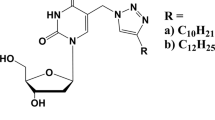No Heading
Purpose.
We previously reported the synthesis of bis(pivaloyloxymethyl) 2′,3′-dideoxyuridine 5′-monophosphate (POM2-ddUMP) (1a) as a membrane-transport prodrug formulation of the free parent nucleotide, ddUMP. Although successful at delivering ddUMP into cells in culture, POM2-ddUMP was rapidly degraded by plasma carboxylate esterases after intravenous administration to experimental animals, and therefore has limited therapeutic potential as a systemically administered prodrug. We now report the synthesis of bis(N,N′-dimethylcarbamoyloxymethyl)- and bis(N-piperidinocarbamoyloxymethyl) 2′,3′-dideoxyuridine 5′-m onophosphate [DM2-ddUMP (1b) and DP2-ddUMP (1c), respectively], analogues of POM2-ddUMP that were designed to be more resistant to degradation by plasma esterases..
Methods.
After entering cell by passive diffusion, it was anticipated that loss of one of the carbamoyloxymethyl groups of 1b and 1c would occur by spontaneous chemical hydrolysis to give the intermediate phosphodiesters, 2b and 2c. Cleavage of the remaining carbamoyloxymethyl groups by cellular phosphodiesterase I would generate ddUMP. 1b and 1c were prepared by condensation of 2′,3′-dideoxyuridine (ddU) with the appropriate bis(N-alkylcarbamoyloxymethyl) phosphate in DMA in the presence of triphenylphosphine and diethyl azodicarboxylate (the Mitsunobo reagent).
Results.
The half-lives of 1b and 1c when incubated at a concentration of 10−4 M in human plasma at 37°C were 3.5 h and 3.7 h, respectively, similar to the half-lives observed under the same temperature conditions in 0.05 M aqueous phosphate buffer, pH 7.4. By contrast, the half-life of the POM2 prodrug, 1a, in plasma was only 5 min. The initial products of degradation of 1b and 1c were the phosphodiesters 2b and 2c. The latter compounds gave rise to ddUMP when incubated with snake venom phosphodiesterase I.
Conclusions.
These findings support the premise inherent in the design of 1b and 1c, namely that the carbamate prodrugs are far more resistant to hydrolysis by plasma carboxylate esterases than their POM counterparts and can revert to the free parent 5′-mononucletides by successive chemical and enzymatic hydrolysis. Further studies of 1b and 1c as membrane-permeable prodrugs of ddUMP are in progress.
Similar content being viewed by others
References
1. J. Beres, W. G. Bentrude, G. Kruppa, P. A. McKernan, and R. K. Robins. Synthesis and antitumor and antiviral activities of a series of 1-beta-D-ribofuranosyl-5-halocytosine (5-halocytidine) cyclic 3′,5′-monophosphates. J. Med. Chem. 28:418–422 (1985).
2. N. W. Bischofberger, R. J. Jones, M. N. Arimilli, K. Y. Lin, M. S. Louie, L. R. McGee, E. J. Prisbe, W. A. Lee, and K. C. Cundy. Preparation of viricidal nucleotide analogs. PCT Int. Appl. 154 pp. (1995).
3. P. D. Cook, G. Wang, T. W. Bruice, V. Rajappan, K. Sakthivel, K. D. Tucker, J. L. Brooks, J. M. Leeds, M. E. Ariza, and P. C. Fagan. Preparation of nucleotide 5′-monophosphate mimics and their prodrugs useful as antiviral, antibacterial, anticancer, and immunomodulatory agents. PCT Int. Appl. 75 pp. (2003).
4. S. Warren. Targetable nucleotide-based prodrugs with cleavable ester linkages. PCT Int. Appl. 137 pp. (1999).
5. K. C. Lieberman and C. Heidelberger. The metabolism of 32P-labeled ribonucleotides in tissue slices and cell suspensions. J. Biol. Chem. 316:823–830 (1955).
6. P. M. Roll, H. Weinfeld, E. Carroll, and G. B. Brown. The utilization of nucleotides by the mammal. IV. Triply labeled purine nucleotides. J. Biol. Chem. 220:439–454 (1956).
7. D. Farquhar, D. N. Srivastava, N. J. Kuttesch, and P. P. Saunders. Biological reversible phosphate protective groups. J. Pharm. Sci. 72:324–325 (1983).
8. S. Khan, B. Nowak, W. Plunkett, and D. Farquhar. Nucleotide bis(pivaloyloxy methyl)esters bypass nucleoside kinase deficiency. Proc. Am. Assoc. Cancer Res. 31:425–426 (1990).
9. K. J. Sastry, P. N. Nehete, S. Khan, W. Plunkett, R. B. Arlinhaus, and D. Farquhar. A newstrategy for the chemotherapy of acquired immune immunodeficiency syndrome: membrane permeable dideoxyuridine monophosphate analogs as a potent inhibitors of human immunodeficiency virus infection. Mol. Pharmacol. 41:441–445 (1992).
10. D. Farquhar, S. Khan,D. N. Srivastva, and P. P. Saunders. Synthesis and antitumor evaluation of Bis[(pivaloyloxy)methyl] 2′-Deoxy-5-fluorouridine 5′-Monophosphate (FdUMP): A strategy to introduce nucleotides into cells. J. Med. Chem. 37:3902–3909 (1994).
11. D. N. Srivastva and D. Farquhar. Bioreversible phosphate protective groups: synthesis and stability of model acyloxymethyl phosphates. Bioorg. Chem. 12:118–129 (1984).
12. O. Mitsunobo. The use of diethyl azadicarboxylate and triphenylphosphine in the synthesis and transformation of natural products. Synthesis (Mass.) 1:1–28 (1981).
13. A. J. Kirby. New synthesis of monoalkyl phosphates. Chem. Ind. (London) 47:1877–1878 (1963).
14. S. Khan. Design, synthesis and biological evaluation of 5′-mononucleotide prodrugs: Strategies to introduce nucleotides into cells. Ph.D. Dissertation UT M.D. Anderson Cancer Center, Houston, TX (1997).
15. S. R. Khan and D. Farquhar. Bis(N,N-dimethylcarbamoyloxymethyl) 2′,3′-dideoxyuridine 5′-monophosphate (DM2-ddUMP): a potential ddUMP prodrug. Tetrahedron Lett. 40:607–610 (1999).
16. H. F. Haugen and S. Skrede. Nucleotide pyrophosphate and phosphodiesterase I. Organ distribution and activities in body fluids. Clin. Chem. 23:1531–1537 (1977).
17. M. Land, R. A. Everard, and L. G. Butler. 5′-Nucleotide phosphodiesterase: features of substrate binding site as deduced from specificity and kinetics of some novel substrates. Biochemistry 19:138–143 (1980).
18. H. G. Khorana and W. E. Razell. Studies on polynucleotides. III. Enzymic degradation; substrate specificity and properties of snake venom phosphodiesterase. J. Bio. Chem. 234:2105–2113 (1959).
19. H. Fukazawa, T. Nishimura, N. Tanaka, and H. Suzuki. 5′-Nucleotide phosphodiesterase and alkaline phospatase in tumor cells: evidence for existence of novel species in the cytosol. Biochim. Biophys. Acta 966:99–106 (1988).
20. H. G. Boman. Snake venom phosphodiesteras exonuclease action. Nature 180:1181–1184 (1957).
21. M. Yoshikawa, T. Kato, and T. Takenishi. A novel method for phosphorylation of nucleosides to 5′-nucleotides. Tetrahedron Lett. 8:5065–5068 (1967).
Author information
Authors and Affiliations
Corresponding author
Rights and permissions
About this article
Cite this article
Khan, S., Kumar, S. & Farquhar, D. Bis(carbamoyloxymethyl) Esters of 2′,3′-Dideoxyuridine 5′-monophosphate (ddUMP) as Potential ddUMP Prodrugs. Pharm Res 22, 390–396 (2005). https://doi.org/10.1007/s11095-005-1876-4
Received:
Accepted:
Published:
Issue Date:
DOI: https://doi.org/10.1007/s11095-005-1876-4




